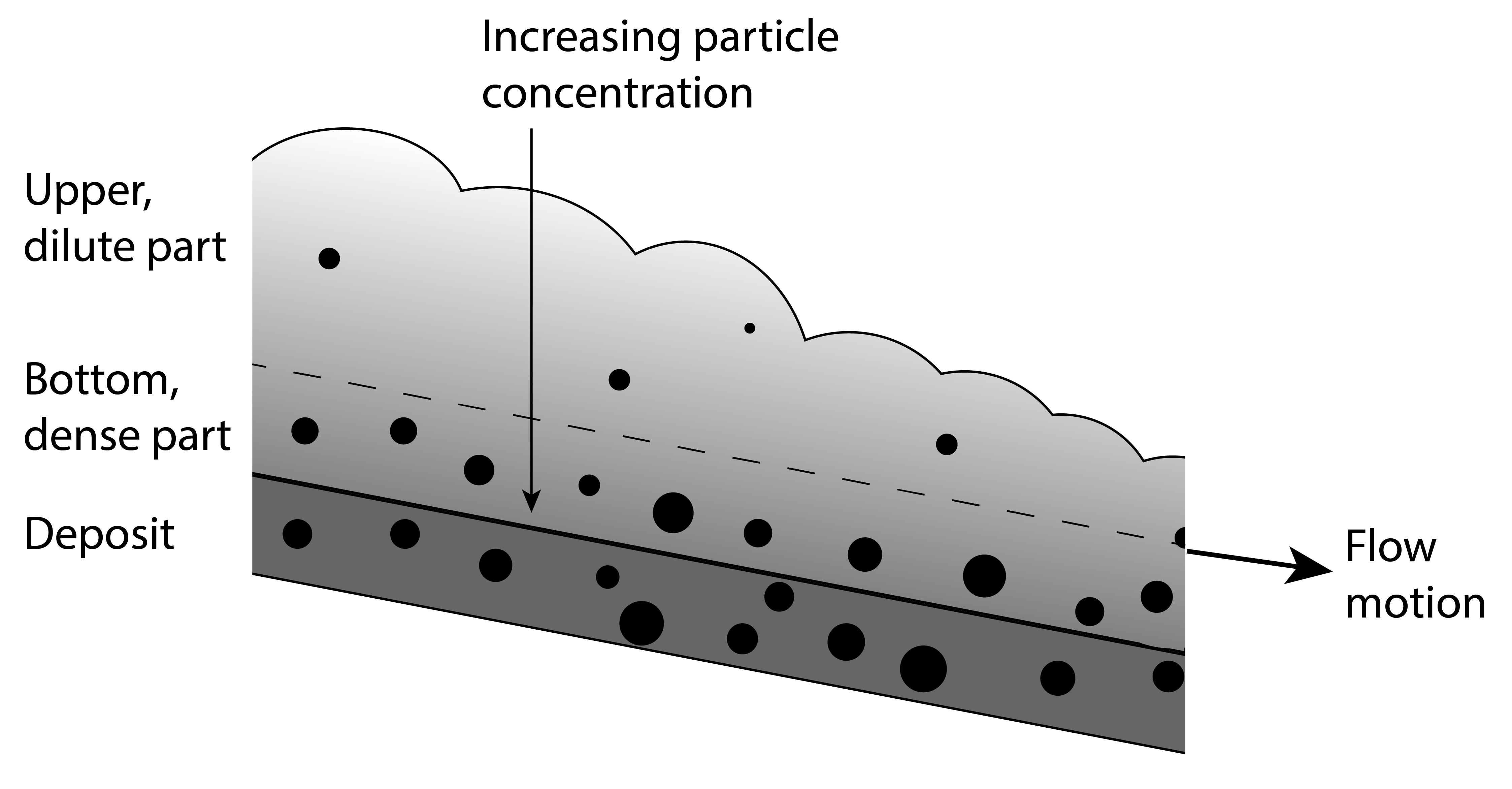Analogue modelling of Pyroclastic density currents
Pyroclastic density currents (PDCs) are hot mixtures of pyroclastic particles and gas that move predominantly horizontally across the landscape, under the effect of gravity1. As stated by Roche and Carazzo (2019)2:
The physics of these currents is certainly one of the most debated issues in volcanology, and in this regard the experimental approach may be particularly insightful.
In fact, the physics of PDCs derives from multidisciplinary investigations, including direct field observations, study of geological deposits, laboratory experiments and numerical simulations. Even if direct observations is the main tool to understand the behaviour of natural phenomena, direct observations are particularly limited in the case of PDCs, notably because of their hostile nature1. Because of these issues, field measurements only yield incomplete and uncertain results, which can be circumvented through laboratory experiments.
Objectives
Taking the example of PDCs, the objective of this section is to illustrate how analogue modelling can contribute to the study of volcanic processes. In more detail, the aim is to:
- describe the main physical properties of natural PDCs,
- select and calculate dimensionless numbers relevant to the study of PDCs,
- show examples of laboratory experiments designed to study PDCs.
Pyroclastic density currents
PDCs are the most hazardous volcanic phenomena for populations living near volcanoes, due to their rapid propagation along the ground, large dynamic pressures, and high temperatures3. They involve some of the most complex and dangerous processes occurring during explosive volcanic eruptions. One of the most tragic demonstration of the destructive power of PDCs occurred in 1902 on the island of Martinique (France), when PDCs caused the death of approximately 30 000 people4.
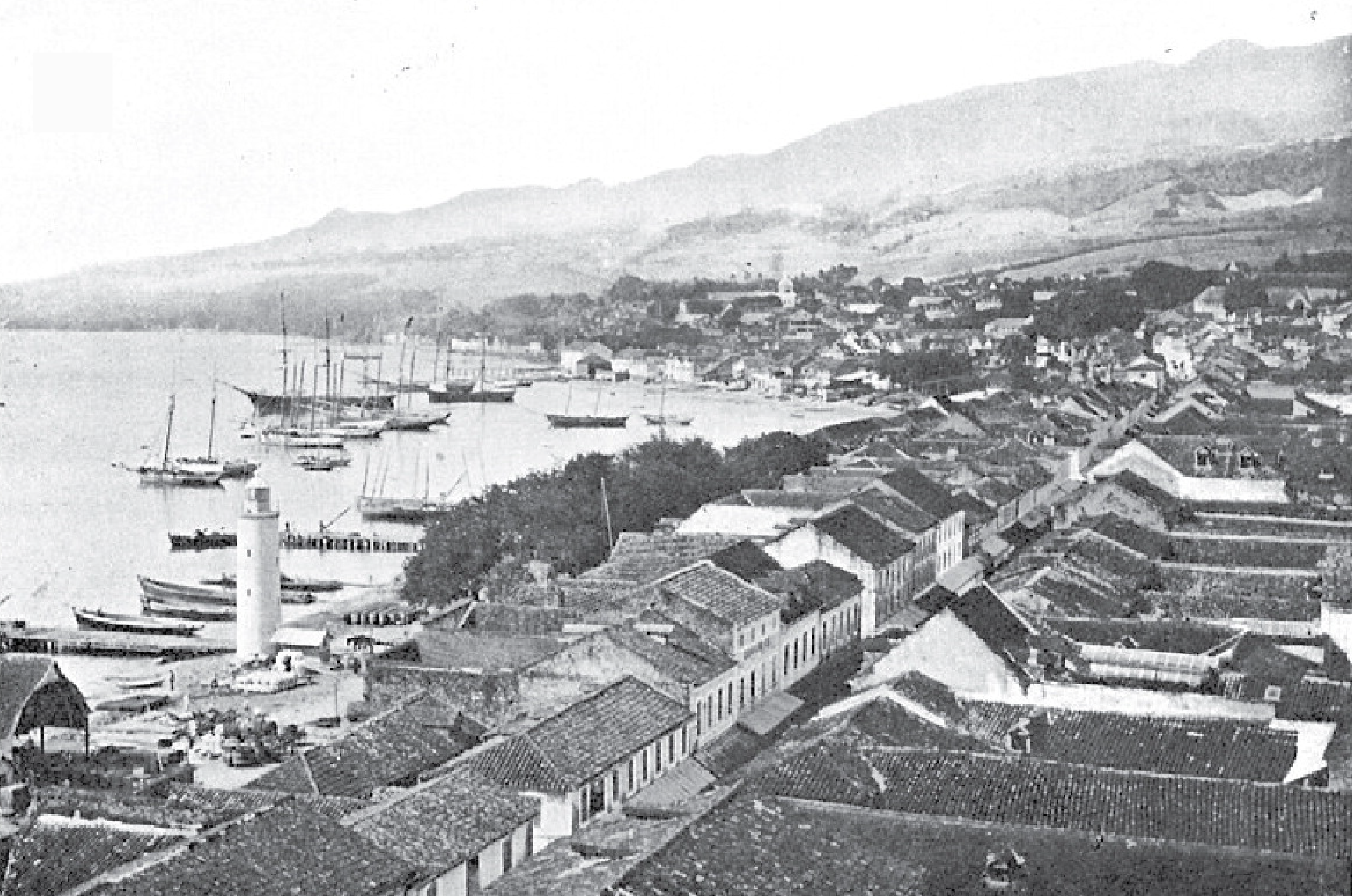

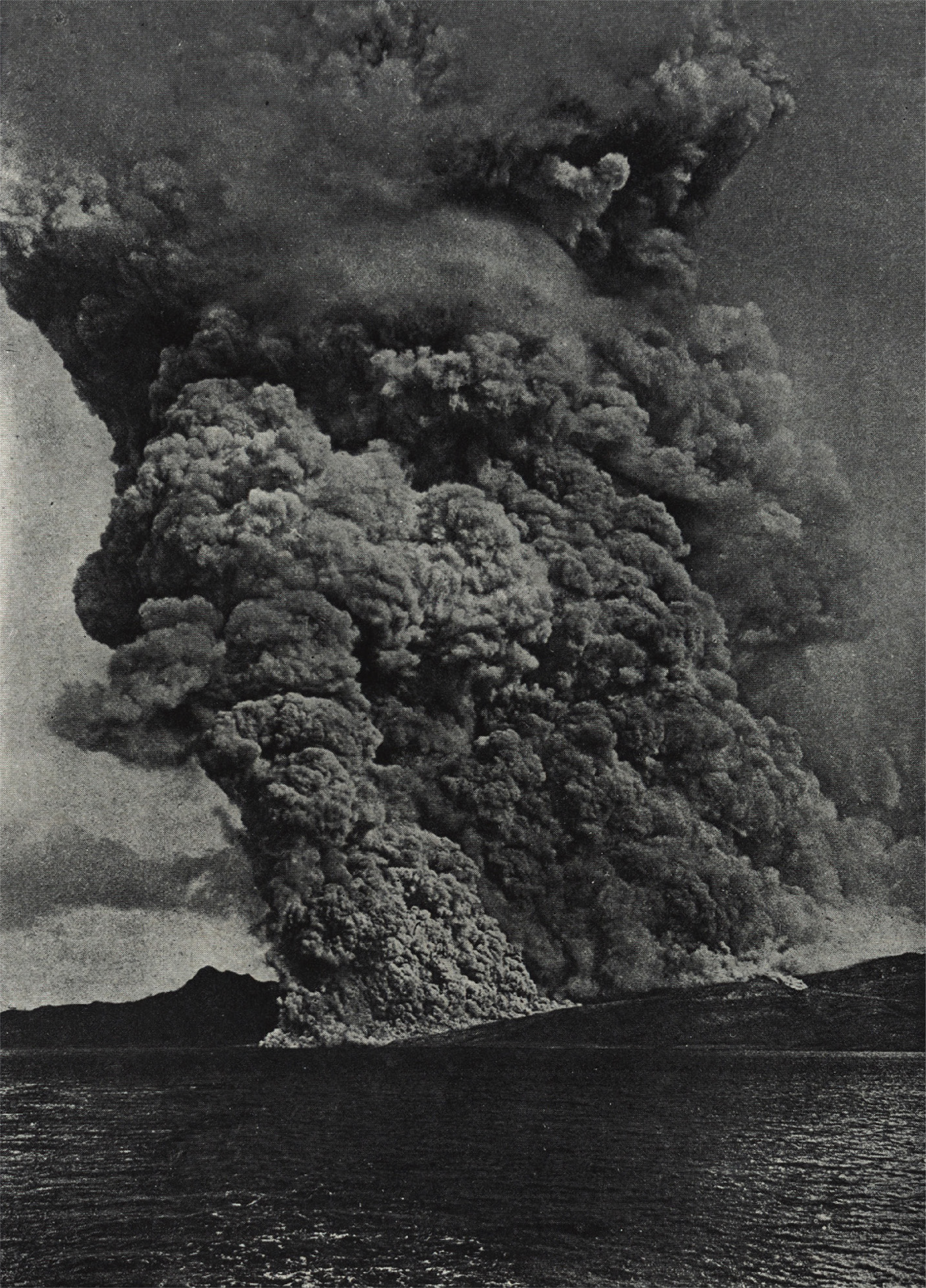
PDCs can be generated by a variety of mechanisms. This notable includes dome collapse, directed blast, or the collapse of an eruptive column. Physically, PDCs are a type of multiphase gravity current. They therefore propagate laterally because the current's density exceeds that of the ambient atmosphere. Investigations have shown that PDCs exhibit a large range of particle concentrations, even within a single PDC. In the past, PDCs were classically separated in pyroclastic surges (for dilute flows with particle concentrations < 1 vol.%) and pyroclastic flows (for dense particle mixtures), but the general term "PDC" is now preferred. Low particle concentration is prevalent in the upper portions of PDCs, whilst the basal part of PDCs often have high particle concentrations3.
Scaling and dynamical regimes of PDCs
As briefly described above, PDCs are associated with different physical processes, notably depending on the mechanisms responsible for their generation. Hence, the scaling of PDCs depends on the specific processes that are adressed by the experiments. This section will focus on the physics and scaling of a dense PDC.
The main parameters describing the physics of dense PDCs are reported in the table below (value ranges are from Roche and Carazzo, 20192). Please note that other parameters may be required, depending on the problem investigated.
| Parameter | Symbol | Range | Units |
|---|---|---|---|
| Flow density | \(\rho_f\) | \(200 - 1500\) | kg m\(^{-3}\) |
| Ambient density (air) | \(\rho_a\) | \(1\) | kg m\(^{-3}\) |
| Particle density | \(\rho_p\) | \(700 - 2400\) | kg m\(^{-3}\) |
| Particle diameter | \(d_p\) | \(10^{-4} - 10^{-2}\) | m |
| Characteristic velocity | \(U\) | \(10 - 150\) | m s\(^{-1}\) |
| Characteristic length | \(L\) | \(1 - 50\) | m |
| Dynamic viscosity | \(\mu\) | \(10^{-5}\) | Pa s |
| Particle volume fraction | \(\epsilon_p\) | \(0.3 - 0.6\) | - |
| Permeability | \(\kappa\) | \(10^{-12} - 10^{-10}\) | m\(^{2}\) s\(^{-1}\) |
| Characteristic shear rate | \(\gamma\) | \(0.1 - 0/6\) | s\(^{-1}\) |
Based on these parameters, it is possible to calculate the values of the following dimensionless numbers and to identify the key forces at play in dense PDCs:
| Dimensionless number | Range | Signification | |
|---|---|---|---|
| Reynolds (\(Re\)) | \(Re = \frac{U L}{\nu}\) | \(10^{5} - 10^{8}\) | \(Re > 10^3\): fully turbulent flow |
| Grashof (\(Gr\)) | \(Gr = \frac{g(\rho_f-\rho_a)L^3}{\rho_a\nu^2}\) | \(10^{11} - 10^{20}\) | \(Gr > 10^3\): turbulent mass transfers; convective flow |
| Froude (\(Fr\)) | \(Fr = \frac{U}{(g'L)^{1/2}}\) | \(10^{-2} - 10^{0}\) | \(Fr < 1\): flow dominated by buoyancy |
| Savage (\(Sa\)) | \(Sa = \frac{\rho_p \gamma^2 d_p^2}{(\rho_p-\rho_a) g L}\) | \(10^{-12} - 10^{-8}\) | \(Sa < 0.1\): particle friction affects flow dynamics |
| Bagnold (\(Ba\)) | \(Ba = \frac{\rho_p \gamma d_p^2 \epsilon_p}{\mu(1-\epsilon_p)}\) | \(10^{-2} - 10^{3}\) | \(Ba < 450\): Intermediate regime, but interstitial fluid viscosity mostly influence the flow dynamics |
| Darcy (\(Da\)) | \(Da = \frac{\mu}{\rho_p \gamma \kappa \epsilon_p}\) | \(10^{2} - 10^{6}\) | \(Da\) is high: solid-fluid interactions dominate (fluid pressure buffers particle interactions) |
As for most volcanic phenomena, dimensionless numbers cover a wide the range of values, often spanning several orders of magnitude. This arises from the variability of volcanic processes that is impossible to describe accurately with narrow parameters. As a result, it can be particularly challenging to identify the dynamical regimes characterising the physics of volcanic phenomena, even based on the value of dimensionless numbers.
For dense PDCs, it is evident from the value of the Reynold number that the flows are fully turbulent (\(Re > 10^3\)). Analogue models must therefore reproduce flows in the turbulent regime in order to be similar to natural PDCs. Moreover, the Grashof and Froude numbers highlight the importance of buoyancy over inertial forces. This force balance also needs to be reproduced in laboratory experiments, although the highest values of the Froude number suggest that inertial forces can be dominant in some cases. Finally, the Savage, Bagnold and Darcy numbers suggest that particle collisions do not have a predominant role on the flow dynamics, that are rather influenced by the presence of interstitial pore fluid pressure. Laboratory experiments studying the behaviour of dense PDCs naturally used granular mixtures to study the role of interstitial fluid pressure on the flow dynamics2\(^,\)5.
Dilute flows
Experimental investigations also adressed the transport of solid particles within dilute flows, where particles are carried by the turbulent fluid phase. Classical experiments commonly involve a given liquid as the current and ambient fluid phases, and they are commonly done in the lock-exchange (or dam- break) configuration (i.e., fluids initially separated by a vertical barrier that is removed at the beginning of the experiments)2\(^,\)6.
However, recent studies also investigated the complex coupling between particles and the gas within dilute flows7, thermal effects, or lateral blasts with laboratory experiments. Relevant dimensionless numbers describing the dynamical regime of dilute flows would not include the Savage, Bagnold and Darcy numbers that are appropriate to characterise dense granular mixture. However, the Stokes and Sedimentation numbers would be necessary to describe the behaviour of particles.
Laboratory experiments on PDCs
The results obtained from laboratory experiments are commonly expressed in a dimensionless form (e.g., as distance, velocity or force ratios) in order to be applicable at all scales for processes in the same dynamical regimes. Here are three examples of results that were obtained from laboratory experiments on granular flows analogue to dense PDCs.
- Sulpizio et al. (2016)8 performed experiments on dry, granular flows using volcanic material released in a flume with changing inclination. The experiments allowed to investigate the behaviour of granular flow passing over a break in slope, and to characterise the morphology of resulting deposits. Results notably showed that the flow runout (i.e., the maximum distance reached by the granular flow) increased because of lower energy dissipation as the slope angle of the upstream channel became closer to that of the depositional area. When expressed in a dimensionless form, this result compared very well with data for non-channelised, natural debris flows.
- Félix and Thomas (2004)9 conducted laboratory experiments on dry granular flows descending on an inclined plane to study the dynamics of dense pyroclastic flows. Their experiments allowed to study deposits of dense granular flows, with a good accordance between field observations and experimental results, notably regarding the morphology of the deposits. A dimensionless scaling law was found between the velocity of dense granular flows and their morphological properties.
- Chédeville and Roche (2015)10 investigated the influence of slope angle on the generation of pore fluid pressure by releasing granular flows in an inclined channel. Their experiments revealed that pore pressure can increase due to air escaping from interstices present in a rough substrate.
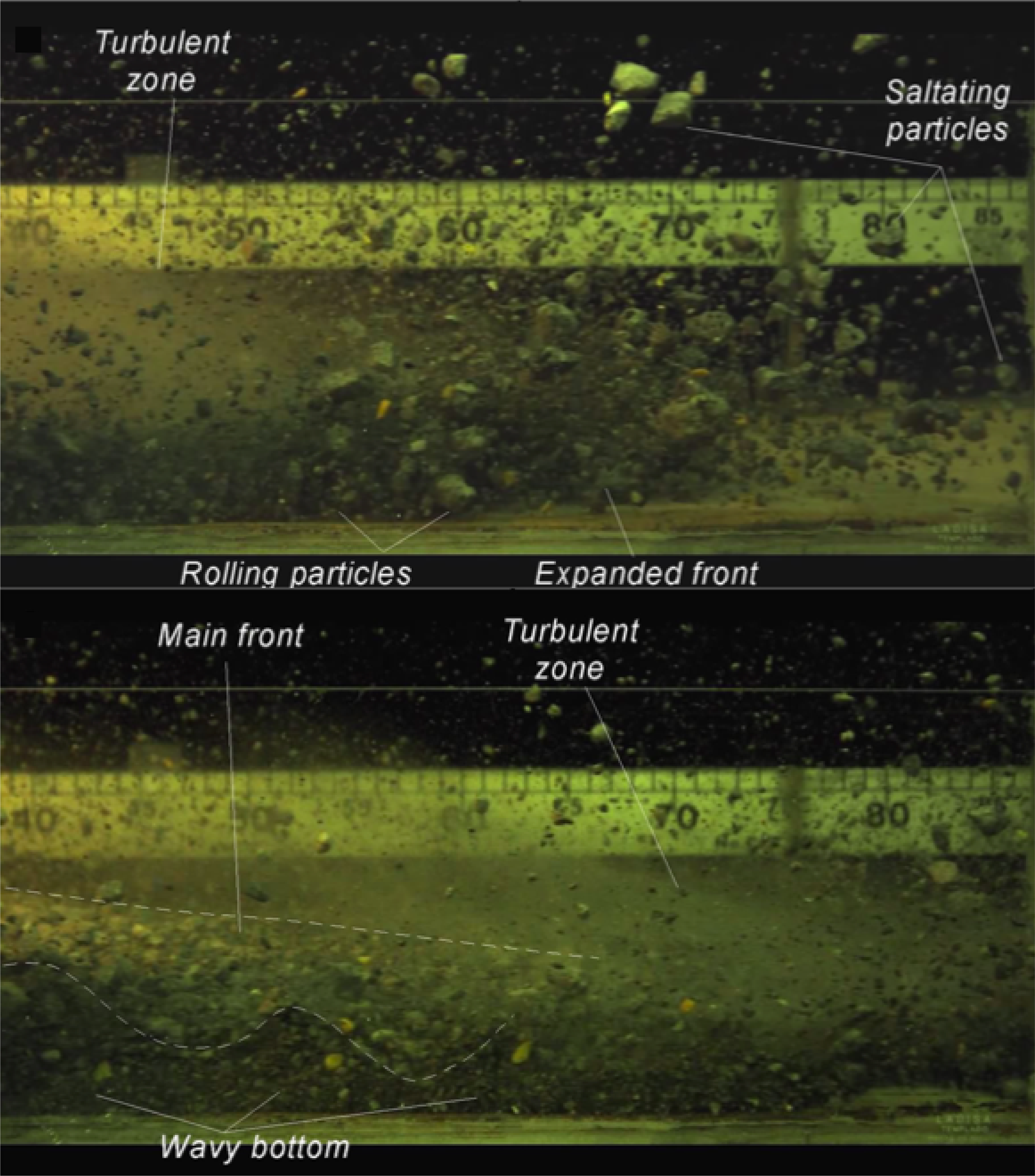
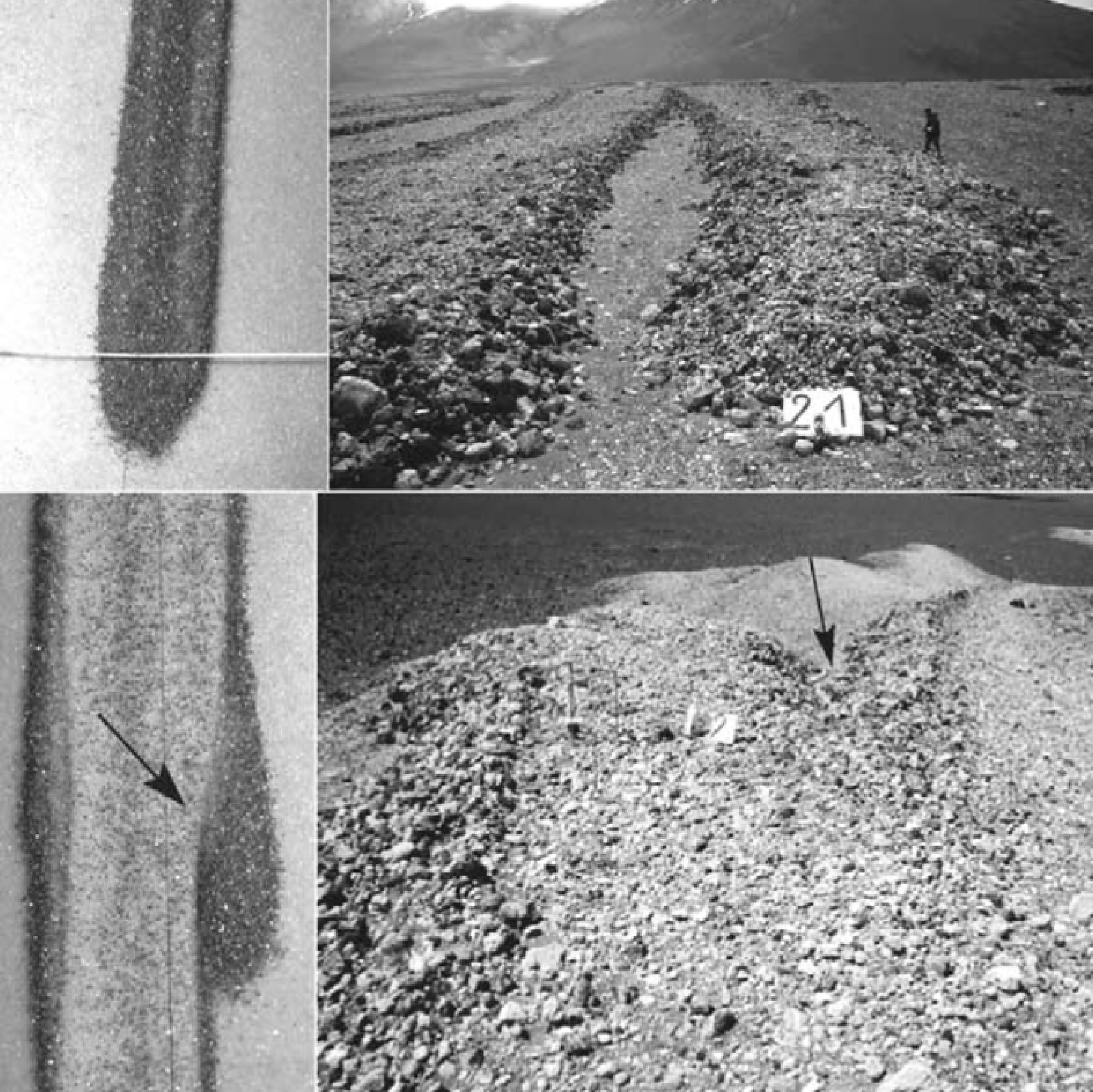
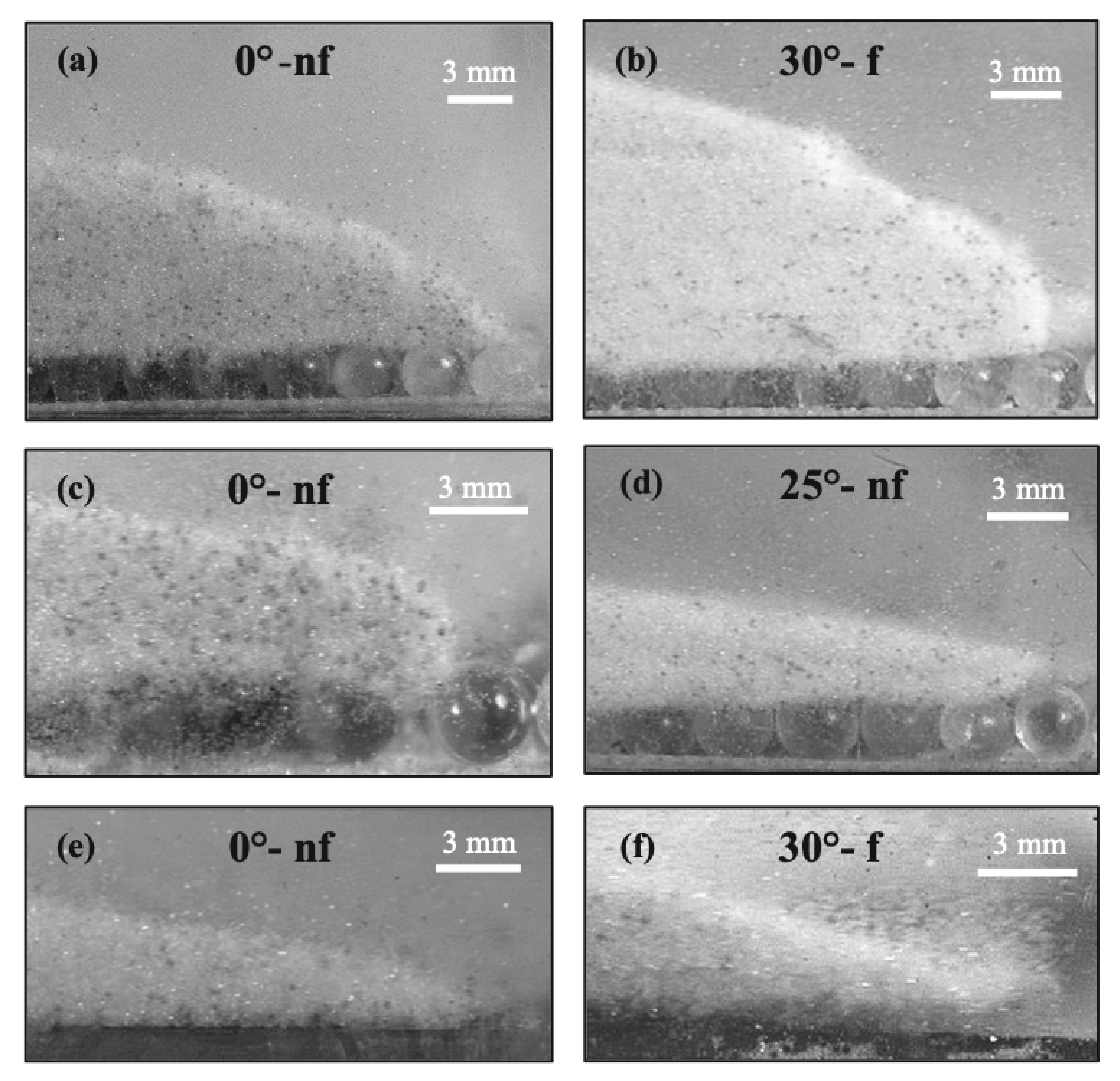
Summary
This section first described the main properties of PDCs, highlighting the importance of analogue modelling for the study of such flows. A scaling analysis was then conducted to identify the main dynamical regimes affecting dense PDCs and to understand the properties that need to be taken into account by laboratory experiments. Finally, few examples of laboratory experiments on dense granular flows concretely showed how analogue modelling can help studying the physical processes at play in PDCs.
The steps applied here to the study of PDCs (and dense granular flows in particular) can be applied to the study of any natural phenomenon in order to understand the main forces affecting their dynamics. Laboratory experiments can then contribute to study these phenomena, and even help circumvented possible limitations inherently associated with field observations.
References
-
Sulpizio, R., Dellino, P., Doronzo, D. M., & Sarocchi, D. (2014). Pyroclastic density currents: state of the art and perspectives. Journal of Volcanology and Geothermal Research, 283, 36-65. ↩↩↩
-
Roche, O., & Carazzo, G. (2019). The contribution of experimental volcanology to the study of the physics of eruptive processes, and related scaling issues: A review. Journal of Volcanology and Geothermal Research, 384, 103-150. ↩↩↩↩
-
Dufek, J., Ongaro, T. E., & Roche, O. (2015). Pyroclastic density currents: processes and models. In The encyclopedia of volcanoes (pp. 617-629). Academic Press. ↩↩↩
-
Lacroix, A. (1904). La Montagne Pelée et ses éruptions. Masson. ↩↩↩↩
-
Fries, A., Roche, O., & Carazzo, G. (2021). Granular mixture deflation and generation of pore fluid pressure at the impact zone of a pyroclastic fountain: Experimental insights. Journal of Volcanology and Geothermal Research, 414, 107226. ↩
-
Benjamin, T. B. (1968). Gravity currents and related phenomena. Journal of fluid mechanics, 31(2), 209-248. ↩
-
Sher, D., & Woods, A. W. (2017). Experiments on mixing in pyroclastic density currents generated from short-lived volcanic explosions. Earth and Planetary Science Letters, 467, 138-148. ↩
-
Sulpizio, R., Castioni, D., Rodriguez-Sedano, L. A., Sarocchi, D., & Lucchi, F. (2016). The influence of slope-angle ratio on the dynamics of granular flows: insights from laboratory experiments. Bulletin of Volcanology, 78(11), 1-11. ↩↩
-
Félix, G., & Thomas, N. (2004). Relation between dry granular flow regimes and morphology of deposits: formation of levées in pyroclastic deposits. Earth and Planetary Science Letters, 221(1-4), 197-213. ↩↩
-
Chédeville, C., & Roche, O. (2015). Influence of slope angle on pore pressure generation and kinematics of pyroclastic flows: insights from laboratory experiments. Bulletin of Volcanology, 77(11), 1-13. ↩↩

